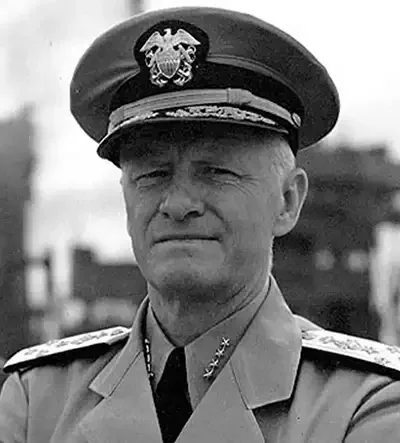- Military History
- Biographies
- Militarians Biographies
- Fleet Admiral Chester Nimitz
Fleet Admiral Chester Nimitz
Commander of the U.S. Pacific Fleet during World War II. One of the navy’s foremost administrators and strategists, he commanded all land and sea forces in the central Pacific area
Chester William Nimitz, a US Fleet Admiral who commanded the Allied land and sea forces in the Pacific during WW II, was born on February 24, 1885 in Fredericksburg, Texas, US.
Nimitz worked from the age of eight and applied for the US Military Academy at West Point to become an Army officer, but no appointments were available. Studying hard, he finally was accepted at the US Naval Academy at Annapolis in 1901 and graduated with distinction in 1905.
After two years of routine duty on the battleship Ohio and the cruiser Baltimore as warrant officer, Nimitz was commissioned as an ensign in 1907. He then served on the gunboat Panay and the destroyer Decatur. When the Decatur ran aground on a mud bank in the Philippines in July 1908 while under Nimitz command, he was court-martialed and found guilty of neglect of duty. Remarkably, Nimitz was let off with a letter of reprimand.
He returned to the US and began instruction in the First Submarine Flotilla. He commanded the USS Plunger, later renamed A-1, the USS Snapper, later renamed C-5, and the USS Narwhal, later renamed D-1. In 1911 Nimitz was appointed Commander of the 3rd Submarine Division Atlantic Torpedo Fleet and assumed command of the USS Skipjack, later renamed E-1.
After commanding the Atlantic Submarine Flotilla from May 1912 to March 1913, Nimitz specialized in diesel engines and developed and built them at plants in Nuremberg, Germany and Ghent, Belgium. Upon his return to the US, Nimitz became the Executive and Chief Engineering Officer of the USS Maumee, the first surface ship in the US Navy to be powered by diesel engines. When the US entered WW I in 1917, the Maumee was stationed about 300 miles south of Greenland, assigned to refuel US destroyers on their way to Britain. During this time, Nimitz supervised the first ever underway refueling and played a key role in the development and refinement of refueling at sea, which gave the Navy and its fleet more independence and which, later in WW II, would prove crucial.
In 1918, Nimitz was appointed Chief of Staff to the Command Submarine Force of the US Atlantic Fleet. During the interwar period, he became a rear admiral and held a variety of posts at sea and on shore until 1939, when he was appointed Chief of the Bureau of Navigation of the US Navy.
After the Japanese attack on Pearl Harbor in 1941, he was promoted to Commander-in-Chief of the US Pacific Fleet with the rank of Admiral, having both land and sea forces under his authority.
Nimitz positioned his carrier fleet to take advantage of the Japanese attack at Midway and the Coral Sea in 1942. By winning these desperate battles, he inflicted heavy losses on his adversaries. He directed a new, shorter line of attack across the Pacific that caught the Japanese defenders flat-footed. He was in overall command during the historic battles of the Solomon Islands (1942–43), the Gilbert Islands (1943), the Marshalls, Marianas, Palaus and Leyte Gulf and supported General MacArthur's invasion of the Philippines (1944). His naval forces captured Iwo Jima and Okinawa in 1945.
On September 2, 1945, Nimitz signed for the United States when Japan formally surrendered on board the USS Missouri in Tokyo Bay.
After WW II Nimitz served as Chief of Naval Operations from 1945 to 1947 mastering the difficult task of reducing the most powerful navy in the world to a fraction of its war-time strength, while establishing and overseeing active and reserve fleets with the strength and readiness required to support national policy. Since his rank of Fleet Admiral is a lifetime appointment, he remained on active duty for the rest of his life, even though in Nimitz later years he served mostly in ceremonial posts.
Chester Nimitz died on February 20, 1966 at 80 at the US Naval quarters on Yerba Buena Island in San Francisco Bay. His remains were laid to rest at the Golden Gate National Cemetery in San Bruno with full military honors alongside his wife and his long-term friends Admiral Raymond Spruance, Admiral Richmond Turner and Admiral Charles Lockwood and their wives, an arrangement made by all of them while living.
Fleet Admiral Chester Nimitz - Quick Facts
- WWI (1914-1918)
- WWII (1939-1945)
- Pacific War (1941-1945)
- {{#owner}}
- {{#url}} {{#avatarSrc}}
{{name}} {{/url}} {{^url}} {{#avatar}} {{& avatar}} {{/avatar}} {{name}} {{/url}} - {{/owner}} {{#created}}
- {{created}} {{/created}}
























